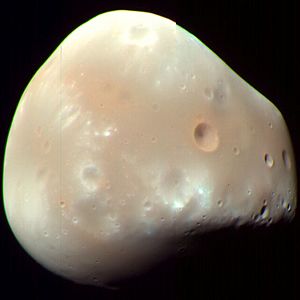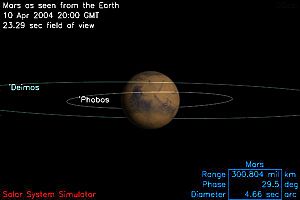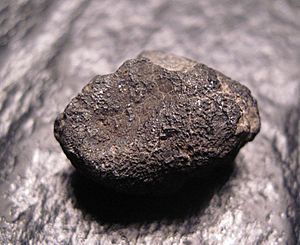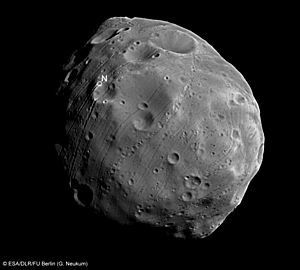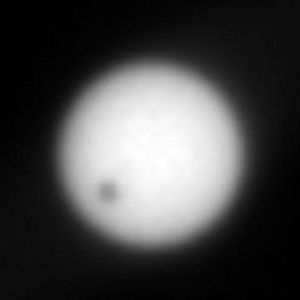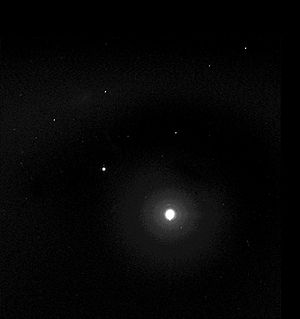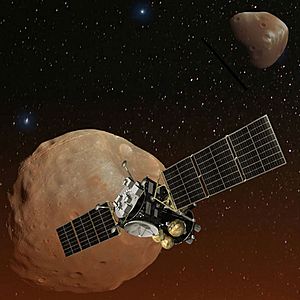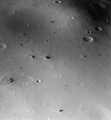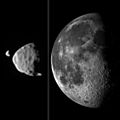Deimos (moon) facts for kids
|
An enhanced-color image of Deimos (MRO, 21 February 2009).
Image: NASA/JPL-Caltech/University of Arizona |
|
| Discovery | |
|---|---|
| Discovered by | Asaph Hall |
| Discovery date | 12 August 1877 |
| Designations | |
| Mars II | |
| Adjectives | Deimosian |
| Orbital characteristics | |
| Epoch 2012-Sep-21 (JD 2456191.5) |
|
| Periapsis | 23455.5 km |
| Apoapsis | 23470.9 km |
| 23463.2 km (6.92 Mars radii) | |
| Eccentricity | 0.00033 |
| 1.263 d (30.312 h) |
|
|
Average orbital speed
|
1.3513 km/s |
| Inclination | 0.93° (to Mars's equator) 1.791° (to the local Laplace plane) 27.58° (to the ecliptic) |
| Satellite of | Mars |
| Physical characteristics | |
| Dimensions | 15 × 12.2 × 11 km |
|
Mean radius
|
6.2 ± 0.18 km (0.97316 mEarths) |
| 495.1548 km2 (97.0755 µEarths) |
|
| Volume | 999.78 km3 (92.2979 nEarths) |
| Mass | 1.4762×1015 kg (0.247179 nEarths) |
|
Mean density
|
1.471±0.166 g/cm3 |
| 0.003 m/s2 (306 µg) |
|
| 5.556 m/s (20 km/h) |
|
| Synchronous | |
| Albedo | 0.068 ± 0.007 |
| Temperature | ≈ 233 K |
| 12.89 | |
Deimos is the smaller and outermost of the two natural satellites of the planet Mars, the other being Phobos. It is one of the smallest moons in the Solar System. Deimos has a mean radius of 6.2 km (3.9 mi) and takes 30.3 hours to orbit Mars. Deimos is 23,460 km (14,580 mi) from Mars, much further than Mars's other moon, Phobos. It is named for Deimos who in Greek mythology is the twin brother of Phobos.
Contents
Discovery
Deimos was discovered by Asaph Hall, III at the United States Naval Observatory in Washington, D.C. on 12 August 1877. Hall also discovered Phobos on 18 August 1877 after deliberately searching for Martian moons. It is named after Deimos, a figure representing dread in Greek mythology.
The origin of Mars's moons is unknown, the main theory are that they formed either by capture or by accretion, the accumulation of particles into a massive object by gravitationally attracting more matter. Because of the similarity to the composition of C- or D-type asteroids, another theory is that the moons may be objects captured into Martian orbit from the asteroid belt, either by atmospheric drag or tidal forces.
Characteristics
Orbit
Deimos's orbit is nearly circular. Deimos is possibly an asteroid that was forced by Jupiter into an orbit that allowed it to be captured by Mars. As seen from Mars it would appear almost star-like to the naked eye. At its brightest ("full moon") it would be about as bright as Venus is from Earth. With a small telescope, a Martian observer could see Deimos's phases.
Deimos rises in the east and sets in the west. From Deimos-rise to Deimos-rise (or setting to setting), 5.466 days elapse. Deimos's orbit is slowly getting larger, because it is far enough away from Mars and because of tidal acceleration. It is expected to eventually escape Mars's gravity.
Geology
Deimos is composed of rock rich in carbonaceous material, and carbonaceous chondrite like Mars's other moon, Phobos. It has an spectra, albedos, and densities similar to those of a C- or D-type asteroid, like most bodies of its size. It is cratered, but the surface is noticeably smoother than that of Phobos, caused by the partial filling of craters with regolith. The regolith is highly porous.
Only two geological features on Deimos have been given names. The craters Swift and Voltaire are named after writers who speculated on the existence of two Martian moons before Phobos and Deimos were discovered.
Atmosphere
The surface of Deimos has no atmosphere of any kind, and it is full of craters from meteors hitting the surface, just like the Earth's Moon. The surface of Deimos is made up of very dark rocks called carbonaceous chondrite, which includes a lot of the element carbon. There is also water ice on the surface of Deimos, as well as most of the interior.
Gravity
Because Deimos is so small, the gravity on Deimos is very, very small. It is about 1/2500th of the force of gravity here on the Earth. This is so little gravity that it would be very dangerous for people to walk on the surface without a tether or some other restraint to keep them from pushing themselves completely away from Deimos, most people could sprint out of Deimos' gravitational zone. If there were a structure on Deimos built for humans, it would resemble an orbital space station inside.
Solar transits
Deimos regularly passes in front of the Sun as seen from Mars. It is too small to cause a total eclipse, appearing only as a small black dot moving across the Sun. On 4 March 2004 a transit of Deimos was photographed by Mars rover Opportunity, and on 13 March 2004 a transit was photographed by Mars rover Spirit.
Exploration
One of the reasons why scientists are interested in exploring Deimos is because it is believed to be an asteroid that was captured by Mars many millions of years ago. By studying Deimos and its brother moon Phobos, scientists hope to get a very close view of what other asteroids of a very similar size also look like elsewhere in the Solar System.
Overall, its exploration history is similar to those of Mars and of Phobos. Deimos has been photographed in close-up by several spacecraft whose primary mission has been to photograph Mars. No landings on Deimos have been made.
The Soviet Phobos program sent two probes to Phobos. In case Phobos 1 succeeded, Phobos 2 could have been sent to Deimos. Both probes launched successfully in July 1988. The first was lost on the way to Mars, whereas the second returned some data and images but failed shortly before beginning its detailed examination of Phobos's surface, including a lander.
In 2008, NASA Glenn Research Center began studying a Phobos and Deimos sample-return mission that would use solar electric propulsion. The study gave rise to the "Hall" mission concept, a New Frontiers-class mission currently under further study. Also, the sample-return mission called Gulliver has been conceptualized and dedicated to Deimos, in which 1 kilogram (2.2 pounds) of material from Deimos would be returned to Earth.
In March 2014, a Discovery class mission was proposed to place an orbiter on Mars orbit by 2021 and study Phobos and Deimos. It is called Phobos And Deimos & Mars Environment (PADME).
Human exploration of Deimos could serve as a catalyst for the human exploration of Mars. Recently, it was proposed that the sands of Deimos or Phobos could serve as a valuable material for aerobraking in the colonization of Mars.
Images for kids
-
The surface of Deimos from 30 km (Viking, 1977)
-
Orbits of Phobos and Deimos (to scale)
-
Curiosity's view of the Mars moons: Phobos passing in front of Deimos in real-time (video-gif, 1 August 2013)
-
Deimos and Phobos as seen from Mars, compared to the Moon as seen from Earth (in angular sizes)
-
Deimos imaged by one of the Viking orbiters
See also
 In Spanish: Deimos (satélite) para niños
In Spanish: Deimos (satélite) para niños


